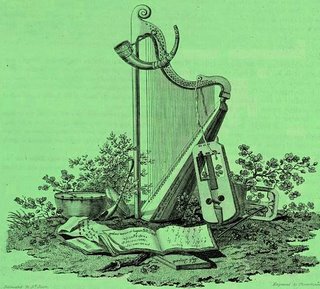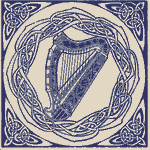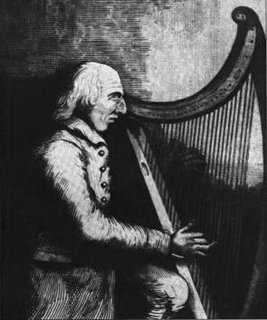
From A History of Irish Music
by William H. Grattan Flood
MUSIC is a universal language, appealing to the very soul of man, and is the outpouring of the heart, whether to express joy or sorrow, to rouse to battle or soothe to sleep, to give expression or jubilation for the living or of wailing for the dead, to manifest sympathy with society or devotion to the Deity. It is, as Thomas Davis writes, "the first faculty of the Irish." He goes on as follows:--
"No enemy speaks slightingly of Irish Music, and no friend need fear to boast of it. It is without a rival Its antique war-tunes, such as those of O'Byrne, O'Donnell, MacAlistrum and Brian Boru, stream and crash upon the ear like the warriors of a hundred glens meeting; and you are borne with them to battle, and they and you charge and struggle amid cries and battle-axes and stinging arrows. Did ever a wail make man's marrow quiver and fill his nostrils with the breath of the grave, like the ululu of the North or the wirrasthrue [A Muire ir Truag] of Munster?"
In ancient Ireland the systems of law, medicine, poetry, and music, according to Keating, "were set to music, being poetical compositions." Vallancey tells us that the bards, specially selected from amongst noble youths of conspicuous stature and beauty, "had a distinctive dress of five colours, and wore a white mantle and a blue cap ornamented with a gold crescent." The curriculum for an ollamh (bard) extended to twelve years and more, at the expiration of which he was given the doctor's cap, that is, the barréd, and the title of ollamh.

Keating assures us that Cormac Mac Art, Ard Righ [Head King] of Ireland (A.D. 254-277), had in his court ten persons in constant attendance:--1, A Prince for companion; 2, a Brehon; 3, a Druid; 4, a Chief Physician; 5, an Ollamh;, 6, an Ard File [head poet]; 7, an Ollamh re ceoil "with a band of music [oirfideadh] to soften his pillow and solace him in times of relaxation:" 8, three stewards of the household. The ollamh, or ollav, be it understood, was the Chief Bard, whilst the oirfideacha were the instrumental musicians. Cormac himself was styled "Ceolach," or the Musical.

Dr. Douglas Hyde, in his monumental Literary History of Ireland, gives by far the clearest and most succinct account of the bardic classifications. The real poet was the file (of which profession there were seven grades), to whom the bard was the merest second fiddle. The Bards were divided into the Saor or patrician class, and Daor or plebeians--with eight grades in each class. They were poets, not musicians--a fact which has not unfrequently been overlooked by writers on this subject.
It is now absolutely certain that the Irish were a literary people long before the coming of St. Patrick; and we have Ogham stones yet preserved which date from the third century, The codices of St. Gall and Bobbio--valuable as they are--must yield supremacy to the oghams, which undoubtedly furnish us with specimens of Gaelic grammar earlier than any known writings. The Irish alphabetic inscriptions in ogham which have survived the hurly-burly of seventeen centuries are mostly on stone, though they were also written on rings, wooden tablets, ivory, bone, gold, silver, lead, crystals, twigs, etc. So far, that is up to the present year (1904), about 340 oghams have been discovered; and whilst some of them are decidedly Christian, the greater number are pagan. Moreover, the deciphering of these quasi-cryptic oghams has been a veritable triumph for the authenticity of ancient Irish history and tradition.
Sixty years ago the savants sneeringly asserted that our ogham inscriptions were "mere tricks of the middle ages, and founded on the Roman alphabet."
Now, however, owing to the researches of Brash, Ferguson, Graves, Rhys, Barry, Power, Macalister and others, the reading of the mystic strokes is almost an exact science.
The very word ogham suggests at once a musical signification, and, therefore, it is of the very highest importance to claim for Ireland the earliest form of musical tablature.
In MacFirbis's MS. Book of Genealogies, there is mention of the three great Tuatha de Danann musicians, viz., Music, Sweet, and Sweet-String, i.e., CEOL, BIND, and TETBIND, whilst the chief harper was named Uathne, or Harmony. Our most ancient writers agree that the Milesians, in their first expedition to Ireland, were accompanied by a harper. The Dinn Seanchus, compiled by Amergin MacAmalgaid (MacAwley), circ. A.D. 544, relates that "in the time of Geide, monarch of Ireland, A. M. 3143, the people deemed each other's voices sweeter than the warblings of a melodious harp; such peace and concord reigned among them that no music could delight them more than the sound of each other's voice." In the same ancient tract there is mention made of music, in the Vision of Cahir Mor, King of Ireland. However, passing over the ages that may be regarded as quasi-fabulous, we come to the close of the third century, when we are on fairly solid historical ground. At this early period the number of Irish minstrels was very great; and there is a record of nine different musical instruments in use.

Heccataeus, the great geographer quoted by Diodorus, is the first who mentions the name Celt, and he describes the Celts of Ireland, five hundred years before Christ, as singing songs in praise of Apollo, and playing melodiously on the harp. The Galatians, who spoke Celtic in the time of St. Jerome, sang sweetly.
There is scarcely any room for doubt that the pre-Christian inhabitants of Ireland had the use of letters, the ogham scale, and the ogham music tablature. The Bressay inscription furnishes an early example of music scoring; and it is quite apparent that the inscriber regarded the ogham and the quaint tablature employed as one and the same--in fact, three of the mystic strokes are identical with three musical signs.
Inasmuch, therefore, as there are genuine ogham inscriptions dating from the third century, we are forced to believe that the music tablature also co-existed at the same early period. Not a little remarkable is it that the very name of ogham writing, namely, Bethluisnin, or Birch Alder tree, is derivable from a tree or branch; and the Irish letters--sixteen in number--are perfectly unique of their kind. Moreover, the trees were called after the letters, and not, as some have alleged, the letters after the trees.
The music pupils in pre-Christian Irish schools had their music staves; and O'Curry describes for us the Headless Staves of the Poets, i.e., squared staves, used for walking (or purposes of defence), when closed, and for writing on, when open, in the shape of fans. And, regarding the advanced state of our ancient bardic poetry, Constantine Nigra writes:
--"The first certain examples of rhyme are found on Celtic soil and amongst Celtic nations, in songs made by poets, who are either of Celtic origin themselves or had long resided among the Celtic races. . . . Final assonance, or rhyme, can have been derived solely from the laws of Celtic philology."
Archbishop Healy tells us that St. Patrick "taught the sons of the bards how to chant the Psalms of David, and sing together the sweet music of the Church's hymns." He adds: "They might keep their harps and sing the songs of Erin's heroic youth, as in the days of old. But the great saint taught them how to tune their harps to loftier strains than those of the banquet hall or the battle-march."
Apropos of the Psalms of David, Biblical commentators agree that the music of the Apostolic age was derived from the Jewish psalmody. The Apostles themselves "adapted" the psalm tunes of the Temple, but, as the Hebrews had no musical notation, the Synagogal chants and melodies, which must have been simple, were handed down traditionally. Very little is actually known of even the shape of the Jewish instruments, as not a single bas relief exists by which we can accurately judge. However, in regard to the vocal department, we can assume that a monotonous recitative gradually developed into occasional modulations, and, in process of time, worked up to an ambitious form of roulade. An irregular form of chant, designated cantillation, was the primitive system of psalm-singing; and it is worthy of note that the modern Arabs recite the Koran in this manner.

Many elaborate essays have been written on Hebrew accents, but, unfortunately, it seems that these accents expressed both the interval, or movement of the voice, and also the melodic succession of notes, with an array of embellishment. Moreover, as Sir John Stainer says, "some of the vowel accents of Hebrew became tonal accents if placed in a particular place with regard to the letters forming the words," which, of course, increases our difficulty in attempting any translation. As is well known, the Hebrews utilized poetry and music as a sort of medium for religious worship, whereas the Greeks cultivated music and the kindred arts solely for arts sake--and thereby evolved an ideal mythological world.
Most musicians are now agreed that the early Christian musical system was not altogether founded on the Greek modes, as, apart from other arguments, the ecclesiastical modes could in no wise be accommodated to Pythagorean tonality. Moreover, for over three hundred years, the early Christians, that is, the Christians of the Catacombs, could not possibly have any ornate form of service; and the music of that period must needs have been of a primitive nature.

Dr. W. H. Cummings, one of the most eminent living English musicians, thus writes:
"I believe the Irish had the diatonic scale as we have it to-day. It was the advent of the Church scales which supplanted that beautiful scale." More recently, Father Bewerunge, Professor of Ecclesiastical Chant in Maynooth College, expresses his conviction as follows:--
"It is thought that the old Irish melodies contain within them the germ that may be developed into a fresh luxuriant growth of Irish music. Now, the Irish melodies belong to a stage of musical development very much anterior to that of Gregorian chant. Being based fundamentally on a pentatonic scale, they reach back to a period altogether previous to the dawn of musical history."
On Easter Sunday, 433, Duththach (Duffy) MacLugair, chief bard of Ireland, gave his adhesion to the tenets of Christianity, as propounded by St. Patrick; and soon after, the Irish minstrels, almost to a man, imitated his noble example. However, so far from the ecclesiastical chant introduced by St. Patrick in aught affecting the music of ancient Erin, it was exactly vice versa. O'Curry, Dr. Sullivan, Archbishop Healy, and others are in error when they assert that Gregorian chant coloured much of the music in Ireland from the fifth to the eighth century. As a matter of fact, "Gregorian" music only dates from the year 593; and it was the Gallic (some say Ambrosian) chant which St. Patrick taught. Even assuming that the plain song of St. Gregory reached Ireland about the year 620, which is improbable, Irish psalmody and hymnody were distinctly Celtic in the first half of the seventh century, and were mainly "adaptations" of the old Irish pre-Christian melodies.




No comments:
Post a Comment